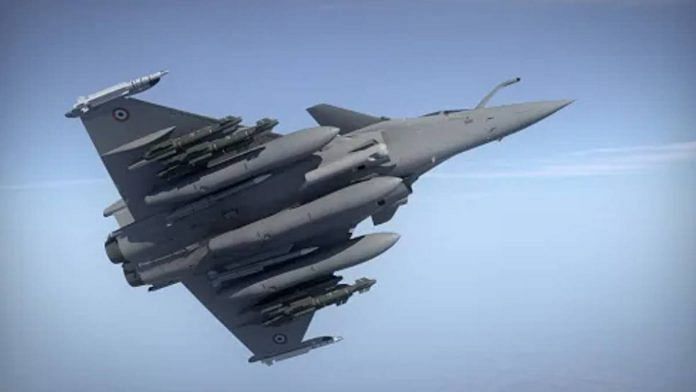New Delhi: India is planning to buy 26 Rafale Marine fighter aircraft from France to arm its indigenous aircraft carrier INS Vikrant, with the deal being approved by the defence ministry during Prime Minister Narendra Modi’s ongoing two-day visit to the country.
While the modalities and prices are yet to be worked out, the deal is expected to amount to approximately 5 billion euros.
The Rafale Marine, also known as Rafale M, was selected following competition with American fighter F/A 18 Super Hornets. Both were flight tested at the shore-based test facility in Goa.
One big advantage the Rafale M had was that the aircraft is already in service with the Indian Air Force (IAF), which means there will be commonality of spares and maintenance, resulting in cost savings.
The Rafale aircraft operated by the IAF and the Rafale M share nearly 80 per cent of their components. The main difference between the two versions of the aircraft is that the nose and main landing gears on Rafale M have been reinforced to satisfy difficult aircraft carrier landing and catapulting conditions.
The Rafale M’s nose gear incorporates the catapult bar and its operating mechanism, along with the “jump strut technology” in the shock absorber. This helps give the aircraft an angle of attack during catapulting, according to manufacturer Dassault Aviation.
“The Rafale M is the only non-US type of fighter cleared to operate from the decks of US carriers, using their catapults and their arresting gear,” the company states on its website.
Also Read: India bumbled along while China grew its navy. Now, embracing the West is the only option
What is Rafale M?
French firm Dassault Aviation’s Rafale M is a single-seat aircraft capable of undertaking ‘quick reaction alert’, air defence and air policing missions, nuclear deterrence duties, power projection and deployments for external missions, deep strike missions, air support for ground forces, reconnaissance missions, and pilot training sorties.
The Rafale M has a wing span of 10.90 metres. In aircraft, the wing span of an aircraft is the distance between its two wingtips situated on both sides. The wingspan generally determines how big the aircraft is. Rafale M has a length of 15.30 metres and a height of 5.30 metres.
Dassault Aviation places Rafale in the 10-tonne class, with a maximum take-off weight of 24.5 tonnes and an external load of 9.5 tonnes. The take-off weight refers to the maximum mass at which the aircraft can take off — this component is certified due to the structural limits of the aircraft.
The “service ceiling” of Rafale M — the altitude at which an aircraft can no longer rise faster than 100 feet per minute under standard air conditions — stands at 50,000 feet.
While the approach speed of the aircraft is less than 120 knots (222.24 km per hour), the maximum speed of the aircraft is 750 knots (1,389 kmph).
The Rafale M can carry out air-to-ground strikes as well as air-to-air attacks and interceptions during the same sortie.
The mission system of the Rafale has the potential to integrate different armaments such as the long-range air-to-air missile Meteor, the air-to-air ‘Beyond Visual Range’ MICA, the HAMMER, long-range stand-off missile SCALP, anti-ship missile AM39 EXOCET, laser-guided bombs with different warheads and seekers, non-guided classic bombs, as well as the 2,500 rounds per minute NEXTER internal cannon.
Dassault Aviation terms the Rafale as an “omnirole aircraft”, meaning that it can perform multiple tasks at once, such as firing air-to-air missiles during a very low altitude penetration phase. The fighter’s design makes it relevant against both “traditional and asymmetrical threats”.
Rafale fighter with French forces
The first variant of the Rafale aircraft (Standard F1) inducted into the French navy featured only air-to-air capabilities. The variant became operational in 2004, launching from the Charles de Gaulle nuclear aircraft carrier during operation “Enduring Freedom” in Afghanistan.
The second version inducted in 2006 brought capabilities to carry out air-to-air and air-to-ground missions.
Standard F3, the current version, was qualified by the French ministry of defence in 2008.
In early 2023, the first Standard F4 Rafale fighters were delivered to both the French air and space force and the French navy. Seven French air force and three French navy units are equipped with the Rafale, according to Dassault Aviation, which calls the fighter “combat proven”.
After the Russian aggression in Ukraine, the French air and space force Rafale fighters, supported by their French navy counterparts, conducted combat air patrol and were kept at short-notice readiness during the winter of 2022-2023 in the Baltic states, media reports said.
(Edited by Nida Fatima Siddiqui)
Also Read: Army, Air Force to take turns at helming 2 of India’s proposed theatre commands, Navy to head third



